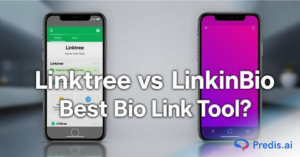With over 56.8% of the world’s population using social media, it is evident that you need to build your presence on these platforms. Sounds overwhelming, right? This is the reason why people invest in social media management. Now the best ones in this field are Buffer and Hootsuite. Both are feature-rich tools due to which many marketing professionals often debate between ‘Buffer vs Hootsuite’. But which one is most suitable for you?
Buffer and Hootsuite take quite different approaches to managing your social media accounts and scheduling updates. They have also taken diverse approaches to product development and have distinct objectives for the feature sets they provide.
So, let’s take a look at what these tools have to offer.
What is Buffer?
Buffer is an easy-to-use tool for posting on social media. It’s quick to set up, and its main strength is how simple it is to use.
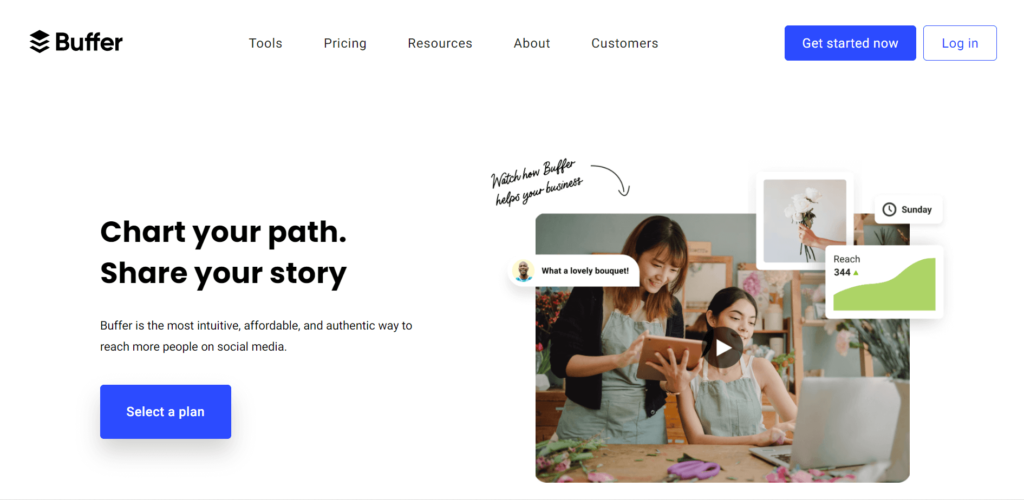
Buffer has many features for analyzing data and creating reports. It also gives helpful tips to grow your social media reach and engagement. It also works with the most recent social features, such as Instagram Stories.
What is Hootsuite?
Ryan Holmes founded and launched the Hootsuite social media management platform in 2008. Its features include content curation and post-scheduling, which cover the majority of areas of social media administration. It even has specialized analytics functions for measuring ROI.

The tool has a simple design and an easy-to-use dashboard where you can view all your social media campaign stats. It also offers team management, collaboration features, and works with many third-party apps.
Buffer vs Hootsuite: Key Features Comparison
Both Hootsuite and Buffer integrate with the majority of the prominent social channels; however, their primary focus is different.
In this section, we’ll compare the features of both of these tools. It will ultimately help social media marketers decide which is ideal for them.
Buffer vs. Hootsuite #1. Posting and scheduling
Buffer and Hootsuite both allow you to publish to your social media profiles. Both platforms also allow you to schedule posts ahead of time and customize them in real-time.
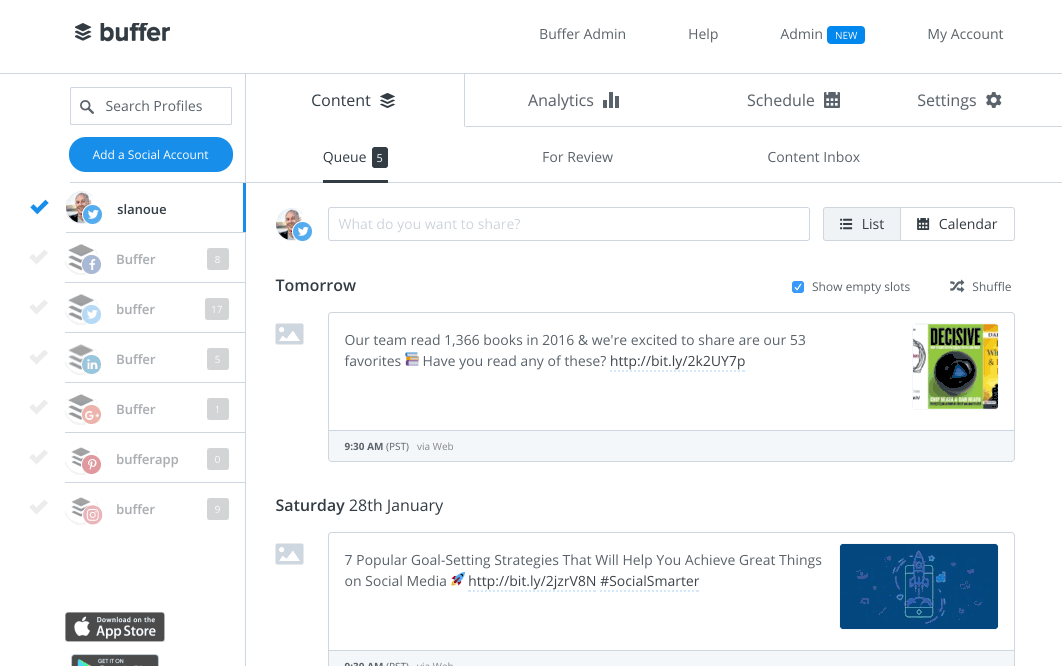
When it comes to scheduling, these applications take different approaches. The Buffer Queue, which provides a personalized timetable of all your posts, is also available from Buffer.
Buffer’s free account limits you to 10 posts per social media account. Buffer has you covered if you want to get a preview of the post you’ve scheduled. However, it is only available with Business or Pro subscriptions. Buffer offers monthly, weekly, and list views.
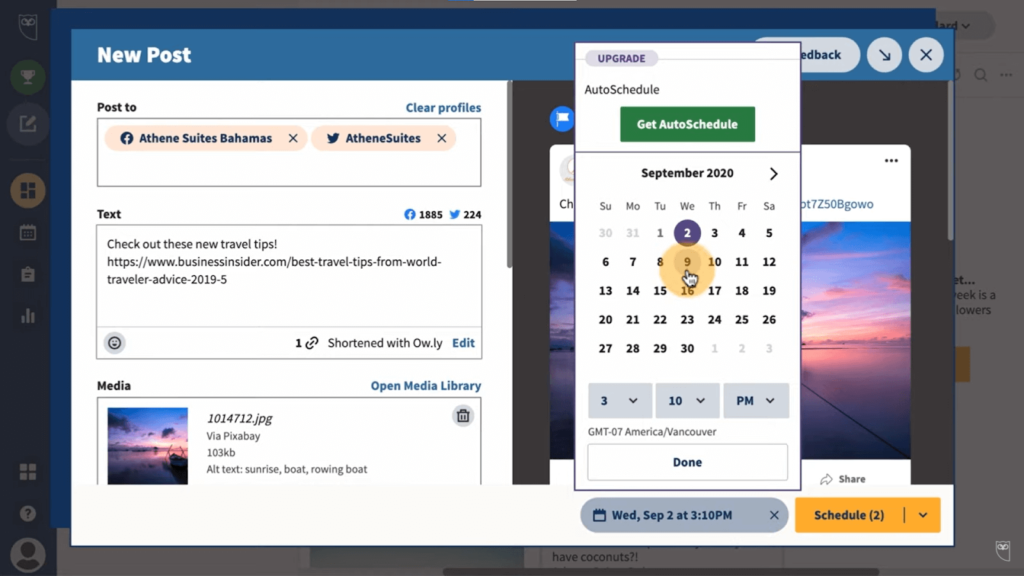
Hootsuite lets you schedule and customize posts manually. It also has an auto-scheduling feature that picks the best time to post. But if you use auto-scheduling, you can’t control the order of your posts.
Hootsuite offers a maximum of 350 scheduled posts across all social media networks using bulk message upload. It also features a draft mode that allows you to save unfinished posts. The Hootsuite Planner only displays one week’s worth of scheduled content at a time.
Hootsuite and Buffer are tied for the top position in this category. Both offer excellent scheduling and publishing capabilities. While Buffer is simpler to use, Hootsuite provides more options for content scheduling flexibility.
Buffer vs. Hootsuite #2. User interaction
Hootsuite and Buffer take quite different approaches to managing social media conversations.
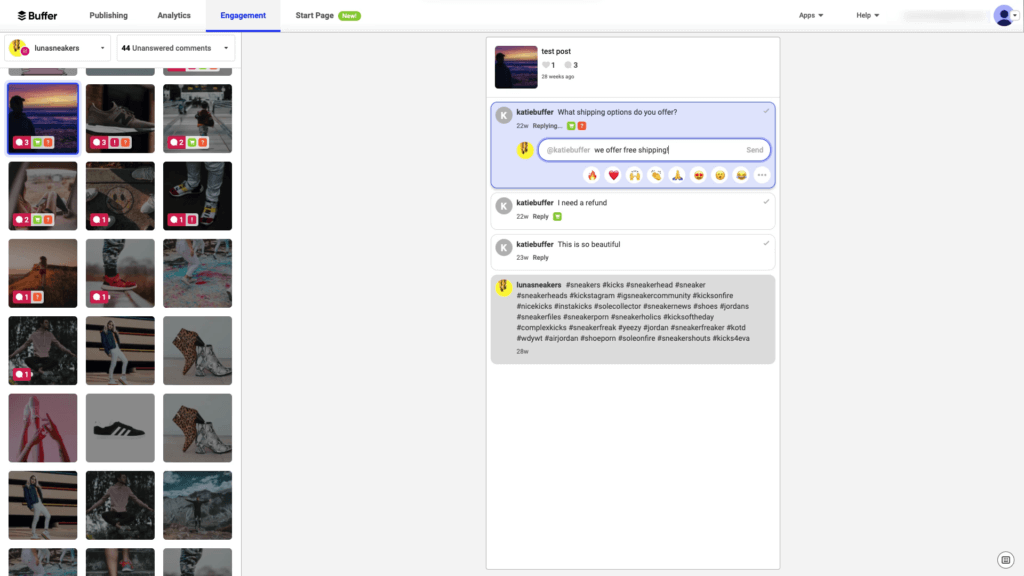
Buffer handles social media interactions through a separate app called Buffer Reply. It has many useful features, but the main drawback is that it’s somewhat pricey.
The basic edition of the Buffer Reply app costs $50 a month. But that’s only for one social media account.
If you want to grow then you’ll need to add users at a rate of $25 per user every month. Therefore, you’ll have to pay $10 per account every month for extra social media accounts.
Despite the costly price, we believe the software is worth it for the variety of services it provides. You can assign tasks to certain team members and make notes for them. In addition, the app records activities in real-time.
Slack and other corporate communication platforms are integrated into the app. If you upgrade to the Business plan, you’ll get access to keyword monitoring tools as well as automation options.
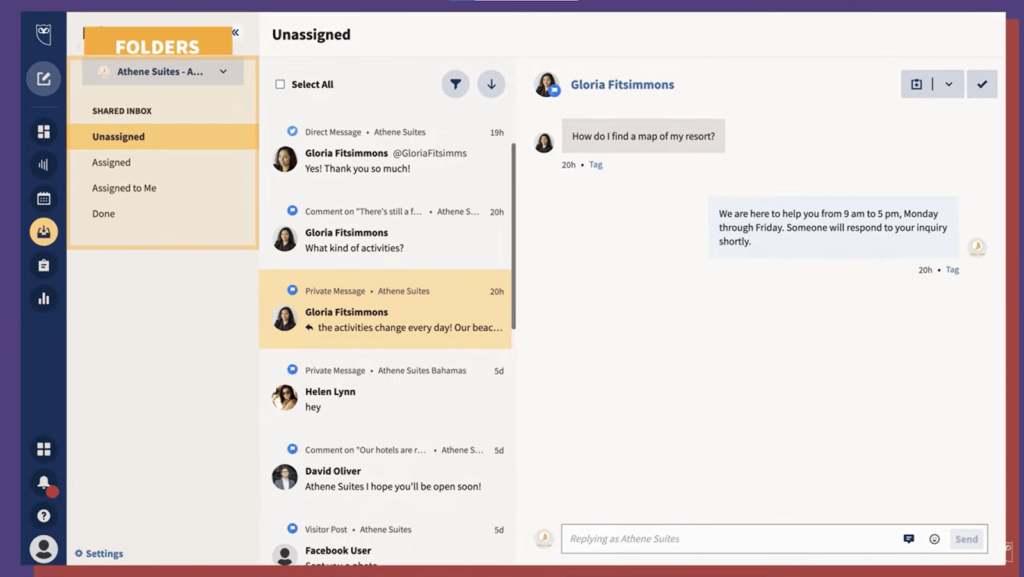
Hootsuite includes social conversation management within the software. It makes handling messages and comments easier because you can customize the dashboard to suit your needs.
Even the free edition of Hootsuite has conversation management functions. Another feature is Hootsuite Streams. It enables you to participate in and reply to social media channel activity in the same way that you would on the original site.
Streams, in my opinion, provide this feature with a distinct advantage. In brief, Hootsuite provides all of the tools you’ll need to respond to and track your social media audience in real-time.
Buffer Reply has a plethora of capabilities that are suitable for small businesses. Hootsuite, on the other hand, is suited for large firms wishing to grow quickly.
Buffer vs. Hootsuite #3. User Interface
The biggest obvious difference between Hootsuite and Buffer is in their user interfaces.

Buffer’s interface is simple, and it displays a queue of all social media postings that are currently scheduled. It’s simple as well as allows you to concentrate on what matters: your scheduled content.
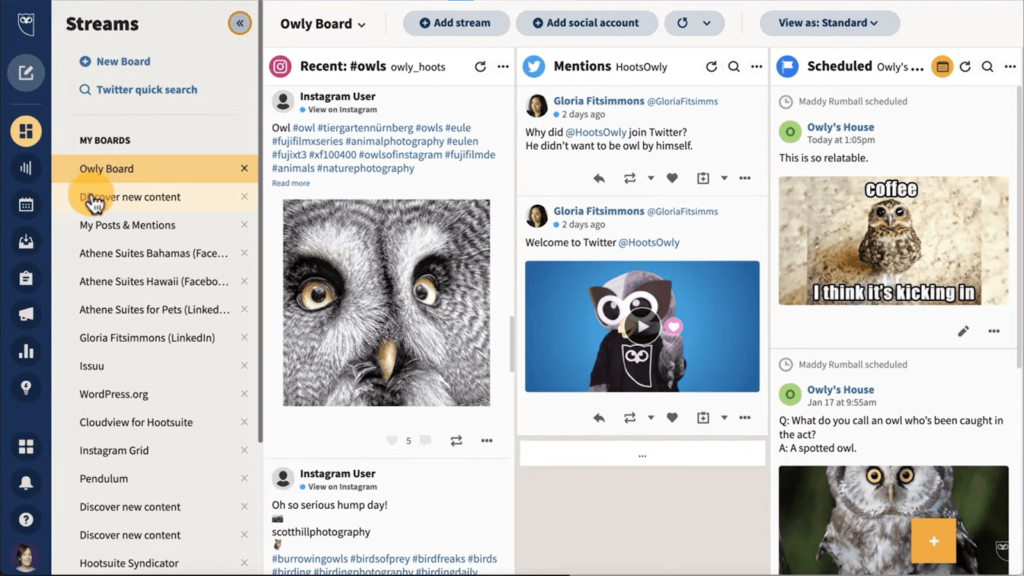
Hootsuite, as previously said, has additional features. So, while the Hootsuite dashboard is not as appealing as Buffer’s, it offers more functionalities.
You can, for example, you can use it to :
- Manage all of your social media accounts
- Check social timelines
- Track remarks across channels
That said, Buffer’s interface is easier to use and more modern. Its simple dashboard helps you manage and edit scheduled posts easily. Hootsuite, however, is harder to learn.
Therefore, Buffer is the good option for individual users and small teams in terms of simplicity and convenience of use. Hootsuite, on the other hand, is better suited for larger teams with a more extensive social media marketing strategy.
Hootsuite’s design is more customizable, but Buffer’s UI is more straightforward to use.
Buffer vs. Hootsuite #4. Reports and Analytics
Social analytics and reporting should be an important part of any social media strategy. You risk losing out if you don’t keep track of what works and what doesn’t. Buffer and Hootsuite both provide a plethora of options for analyzing audience reactions to your social media activities.
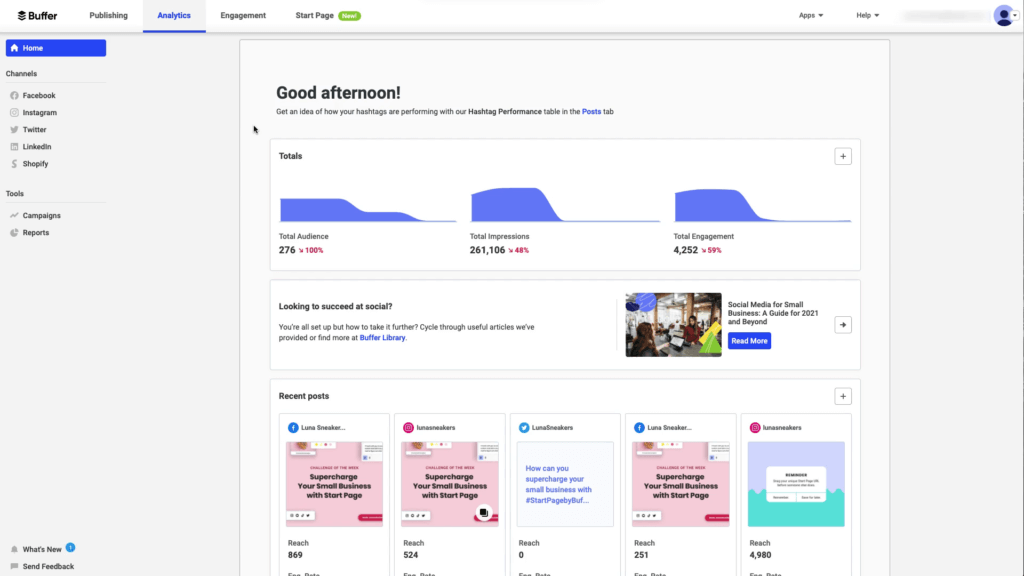
Buffer, as previously said, is primarily a content publishing platform. As a result, it only provides metrics for posts made using its interface. Therefore, you will not receive in-depth reports on how the posted content on the native social applications performs.
However, social media managers will like Buffer’s user-friendly Buffer Analyze tool. It allows you to monitor performance based on interaction, post type, and reach.
Buffer is a mobile app that allows you to track your social performance while on the road. You can also export all of the data for additional study.
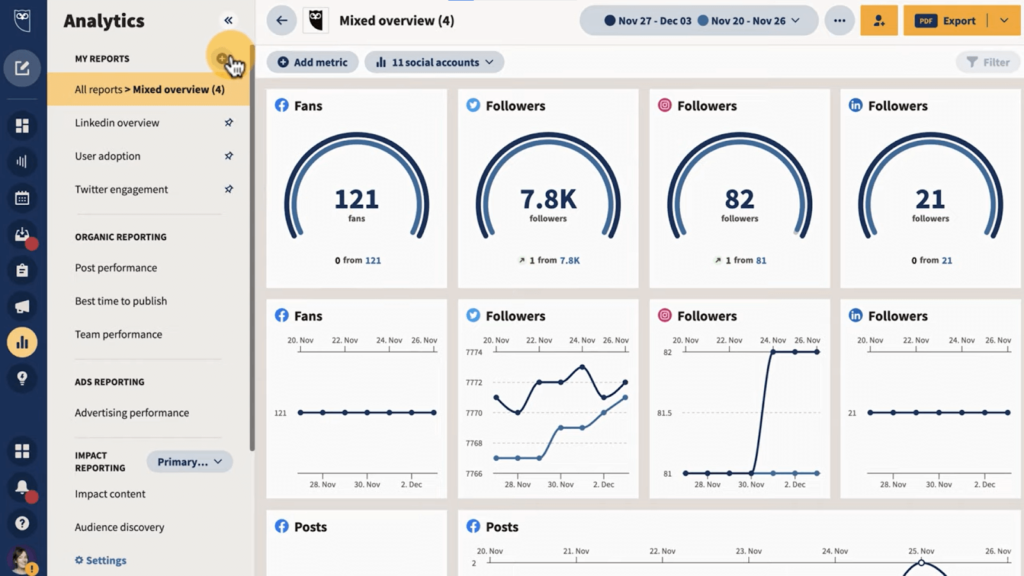
Again, both Buffer and Hootsuite have analytics tools. However, Hootsuite is a place on the top as it offers statistics on all social postings including even on the free plan.
Buffer, on the other hand, is restricted in its capabilities and only works with content posted from the tool. There’s also the problem that it doesn’t provide any analytics services on its free tier.
Buffer vs. Hootsuite #5. Managing teams
The number of individuals on your social media team can influence whether you choose Buffer or Hootsuite. Both, as scheduling tools, allow you to assign certain accounts to specific team members.
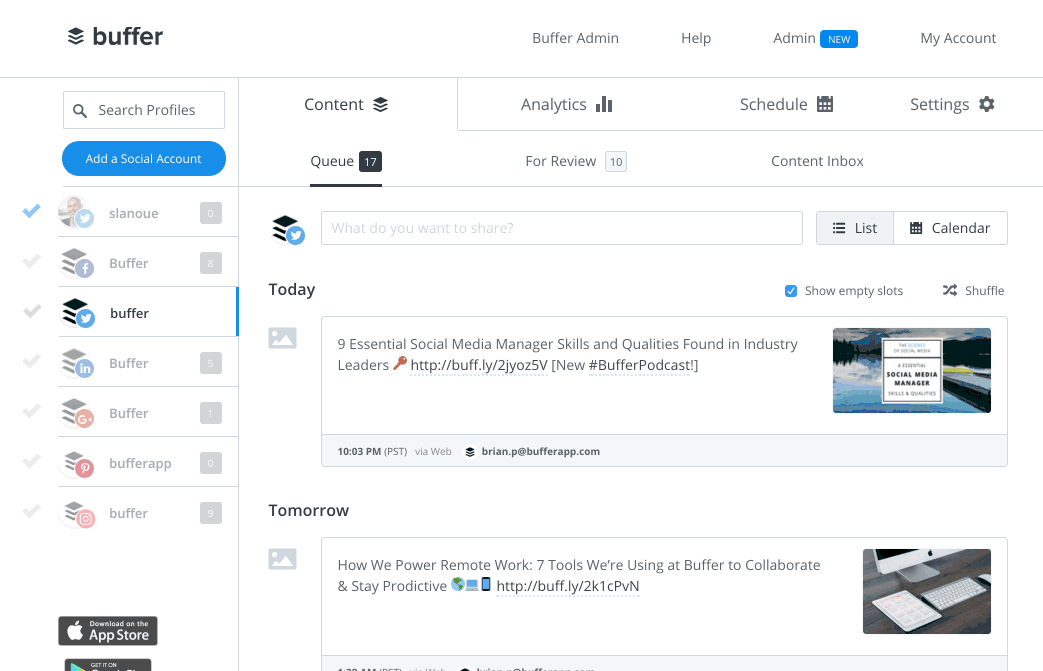
When collaborating with Buffer, you must manually pick which social media accounts your teams will administer. You’ll have two authorization levels on this platform: Contributor and Manager.
You can use these to either allow contributors to complete posting rights or to maintain the requirement for permission before publishing.
This straightforward approach is now appropriate for smaller firms with a limited number of social accounts. Hootsuite offers additional services for larger organizations with a strong social media presence.
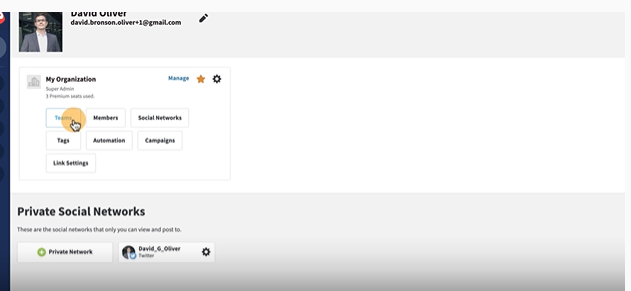
With Hootsuite, you can divide your teams into individual members or groups. On an organizational level, you can even form groups of teams. This makes it easier to enable large-scale marketing activities.
In terms of collaborative functionality, both platforms are equivalent. The only distinction we can see is that Buffer offers a more clear approach that is better suited for smaller teams. Hootsuite is the superior option for larger enterprises.
Buffer vs. Hootsuite #6. Calendar view
The main function of social media marketing tools is to schedule posts across many social media networks. Having said that, practically all social media management solutions have a calendar view. It shows the days and times when posts are planned to be published. It is critical to be able to move posts on the calendar quickly and easily.
Buffer and Hootsuite both allow you to schedule posts ahead of time that will appear on a content calendar. However, there are a few minor changes in how each platform schedules posts and how they appear in the separate content calendars.
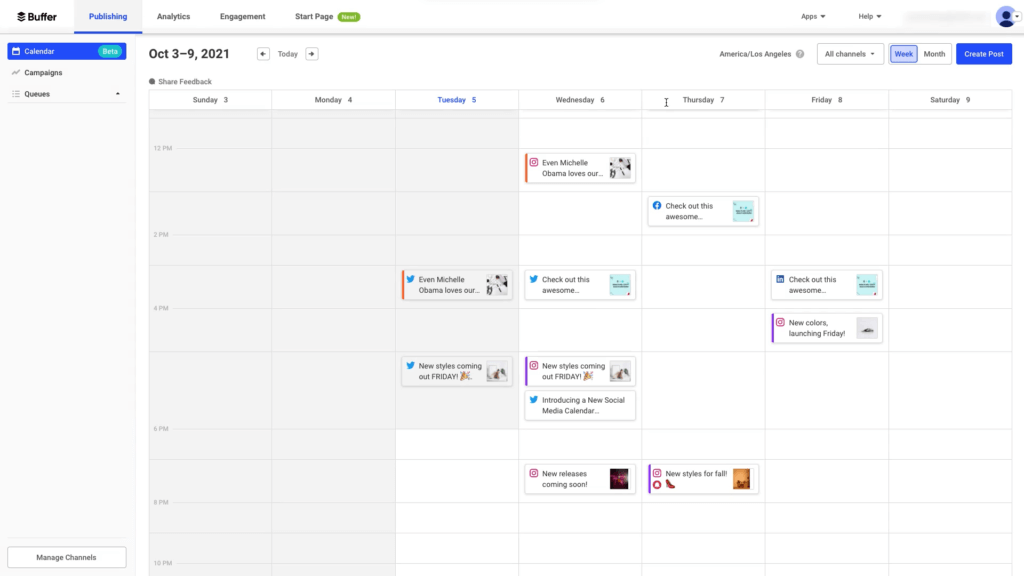
Buffer’s content calendar is a new addition to the platform. After you’ve scheduled your posts in your calendar, you can move the post blocks to other times by clicking and dragging the blocks.
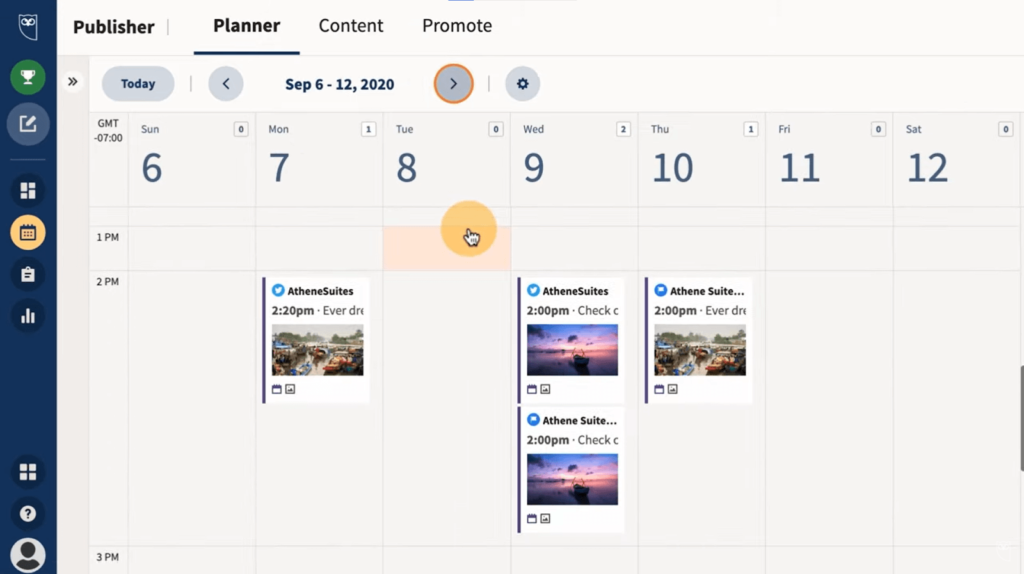
Hootsuite is one of the greatest platforms in the market, and it has always included a calendar view. Every one of your posts is simply displayed week by week. You may also reorganize them with a simple drag and drop.
However, you cannot view the entire month at once. Given that most other social media marketing tools do, this is a significant drawback.
Buffer vs. Hootsuite #7. Bio-Link feature
Both platforms let you construct bio link pages that you can use in your social media bios.

Buffer allows you to construct branded landing pages that route users from social media to a page where, presumably, you want them to take some form of action.
You can also design store pages that resemble Instagram shop pages. Alternatively, you may utilize these landing pages as bio links to highlight multiple links in your social network bio area.
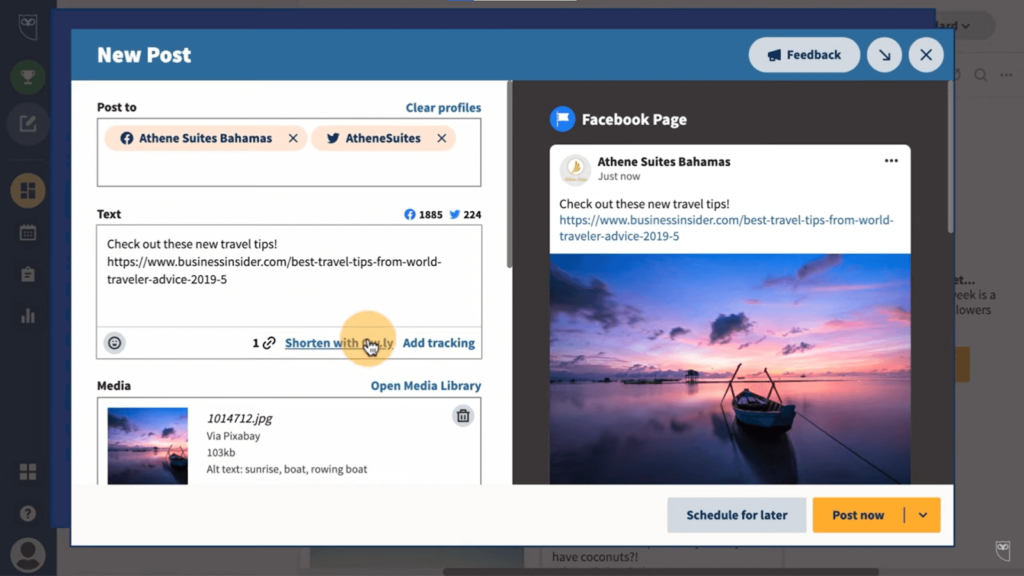
The “oneclick.bio” tool in Hootsuite allows you to create a link tree directly from your dashboard.
You can create an Instagram landing page that leads to:
- Landing pages on your website
- Products in your store
- Other connections on your website.
You can use Instagram photos to make an infinite number of customized pages.
Buffer vs. Hootsuite #8. Pricing
Buffer and Hootsuite both provide restricted free services for customers with simple scheduling needs. You can link up to three social accounts with a single user in each tool. Buffer gives you 10 scheduled posts for free, but Hootsuite gives you 5.
Paid options begin at $6 per month per channel for Buffer and $99 per month for Hootsuite (Professional plan). However, at this level, comparing the two applications becomes more difficult.
On this subscription, Buffer allows you unlimited per channel. Hootsuite has an infinite number of posts across ten social accounts.
The rest of Buffer and Hootsuite’s plans are aimed at businesses of various sizes.
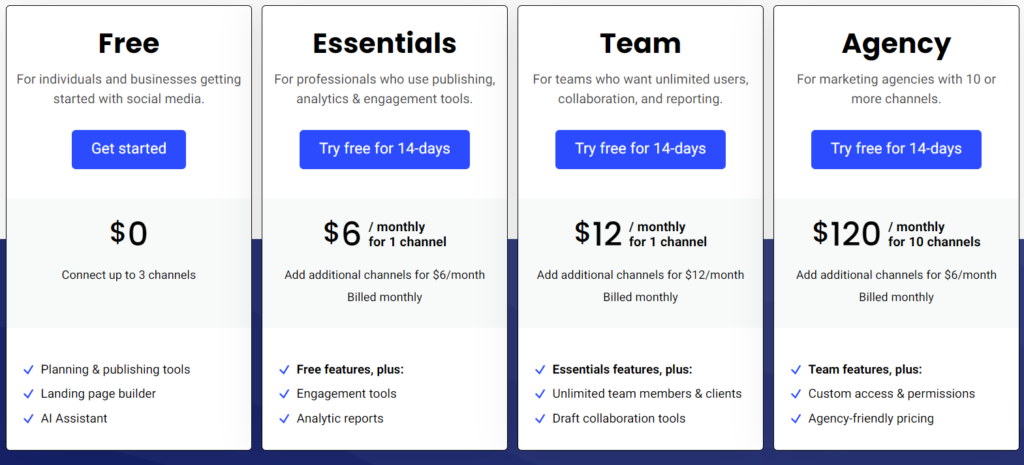
Buffer named its pricing plans as per the types of businesses it feels will benefit from them.

Comparing Buffer and Hootsuite pricing plans is similar to comparing apples and oranges. Buffer is the least expensive of the two.
However, Hootsuite provides comprehensive social media management capabilities at a reasonable price. Furthermore, it requires a lengthy trial time for you to try both tools.
Buffer vs. Hootsuite #9. Customer Support
In terms of customer service, both tools provide a satisfactory experience. Buffer is active on Slack and Twitter, and it also offers email support. Hootsuite offers a live chat component and is active on social media platforms.
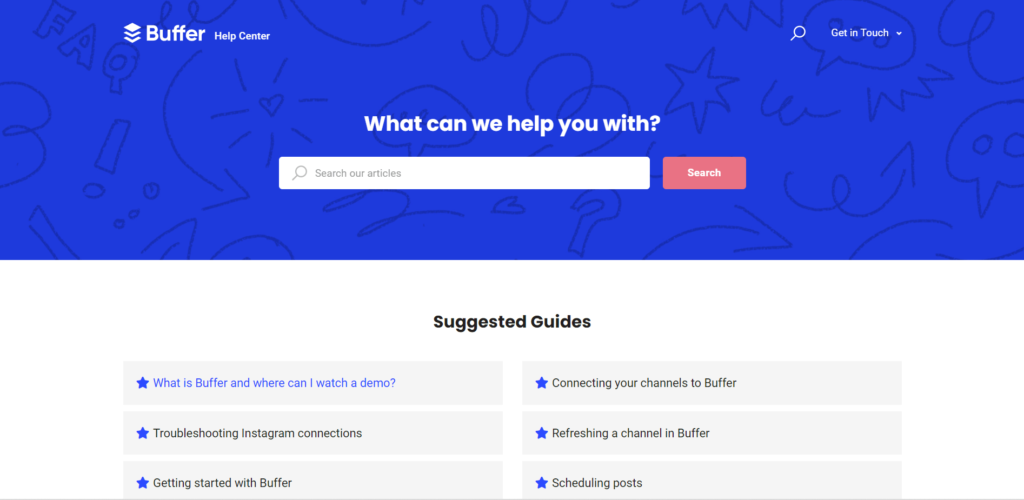
To assist new users, Buffer provides a variety of tools such as blogs, guidelines, FAQs, and online tutorials. They even provide webinars regularly where corporate specialists teach people how to get the most out of social media.
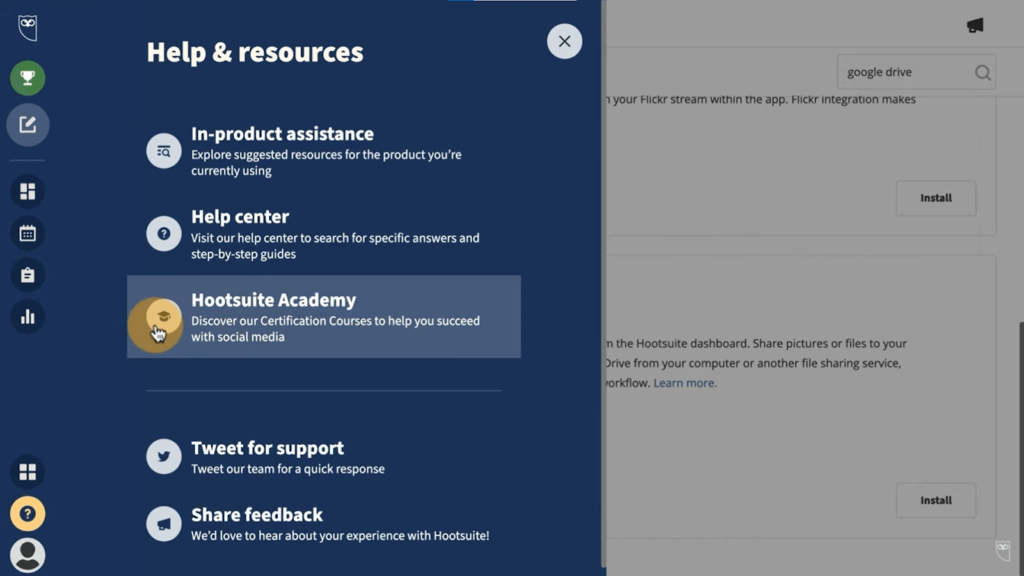
Hootsuite has an academy with free and paid courses on social media marketing. The courses are for individuals and business teams. Some offer certifications and can count toward college credits.
Both tools are equivalent in terms of customer support, yet Hootsuite is the winner in this category. Its live chat feature allows for real-time problem-solving. Buffer’s email replies, on the other hand, take longer.
Buffer vs. Hootsuite #10. Available integrations
Hootsuite much exceeds Buffer in terms of the number of integrations.
Buffer has roughly 60 integrations, whereas Hootsuite has around 150+.
Hootsuite offers tools for digital marketers such as ad management, marketing automation, and influencer marketing. With so many integrations, there isn’t much you can’t do with it.
Hootsuite gets the top spot in this category. Its extensive list of integrations ensures that your social media needs are met without any problem. Buffer isn’t far behind, but it’s still not on the same level as Hootsuite.
Buffer vs. Hootsuite #11. Hootsuite’s OwlyWriter AI vs. Buffer’s AI assistant
Being the first social media management platform, Hootsuite surely has maximum expertise in creating compelling social media posts. That’s how the OwlyWriter AI allows you to generate unique and compelling social media posts and content ideas with minimal input.
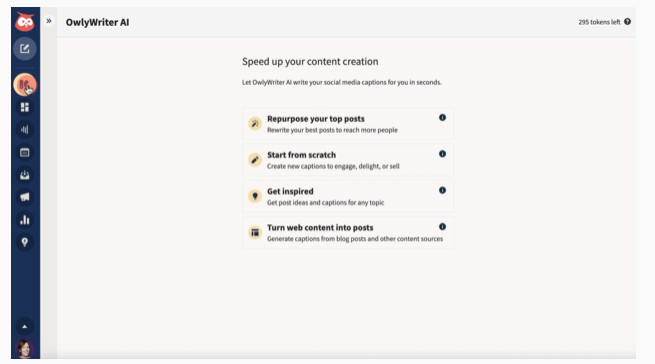
Buffer’s AI assistant helps you create social media posts, summarize your long-form content into short posts, and repurpose your posts. But if you want to create the best posts with already existing content you need to try the OwlyWriterAI. Here, you can use previous top-performing content to create new posts without duplication using the repurpose tool.
It is important that the created content is a perfect match to your brand tone or voice. So if you want to personally customize it, Ai Assistant is your go-to option. Similarly, if you trust that AI can handle your brand tone perfectly, go with the OwlyWriter AI. It can generate your content in your desired brand voice with a simple input.
Taking into consideration that the created content follows the latest trends and events, both OwlyWriter AI and AI assistant can be helpful. Hootsuite’s AI is aware of all the upcoming holidays and events, thus helping you create trendy celebratory content. However, AI Assistant uses advanced algorithms to analyze the latest trends and social media data patterns.
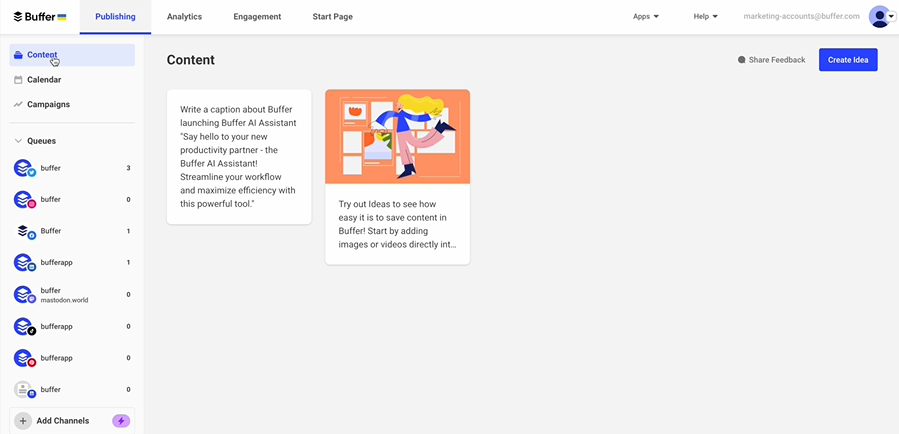
Want to get out of your writer’s block? Get a list of top content ideas with a simple prompt using OwlyWriter AI. Additionally, you can generate multiple versions for your social media posts to compare and select the best with the AI assistant.
Buffer vs. Hootsuite #12. Content approval features
Upset with unwanted and incorrect social media content publishing? These are basic problems a social media management team with multiple members may face. Sometimes, there may be unwanted problems such as inappropriate post timing or irrelevant content. However, to avoid these problems, both Buffer and Hootsuite provide you with a content approval feature.
Buffer provides a straightforward feature where you can draft your content or use the publishing tool to send it for approval. You can easily manage who will have the drafting and publishing permissions among your team members. This feature provided by Buffer is best suited for agencies with multiple team members.
Hootsuite won’t be left behind here. Its content approval feature allows everyone on the team to have a look at the progress made. Team members can easily view all the scheduled posts and posts that are approved or pending approval. The administrator can set up which posts require approval thus avoiding problematic publishings.
Buffer vs. Hootsuite #13. Content recommendations
If you are a social media manager, you will know how helpful a content recommendation can be for a blooming manager. The beginning in this field can sometimes leave you blank about what to create next. This is when you can seek help from content recommendations that will give you post ideas relevant to your audience.
Though they are very helpful, not many people are aware of it. Buffer also used to have these recommendations but it decided to withdraw them. They felt that content recommendations were not true to the purpose of their mission.
But if you look at Hootsuite, it will provide you with suggestions based on trendy topics, popular hashtags, and relevant industry news. These suggestions help users to find content ideas for their next post. Otherwise, you can visit your content library to grab new ideas from previous posts.
Buffer vs Hootsuite #14. Content Library
Isn’t it helpful to save all your work for later use? A content library stores all your digital content in one place for easy access. You can use it to manage and share media for marketing. These libraries also support the internal team with external marketing efforts.
This amazing feature of the content library is unfortunately not available with Buffer. However, if you are really in need of one, you can always rely on Hootsuite. Over the years Hootsuite is smoothly upgrading itself according to user needs.
Hootsuite users can easily organize, save, and search their content in the tool. It further allows you to tag your content so that it can be easily found. Additionally, you can view the usage stats and stay updated on how the library content is leveraged for external marketing.
So I guess being the first social media management platform works out for you at times. Hootsuite with over 15 years of experience, is actually running a step ahead to provide the best services to its users.
Supported social media channels (Table)
Buffer allows you to manage Facebook pages and groups, as well as LinkedIn pages and accounts. If you have the Pro version, you can work with and manage up to eight different profiles. Buffer does not support YouTube; for that, you must rely on Hootsuite.
Hootsuite interfaces with all of the channels mentioned above, as well as WordPress and YouTube. You can use it to schedule posts and content, monitor timelines, and manage all social media feeds.
| Social Media Platforms | Buffer | Hootsuite |
| Yes | Yes | |
| Yes | Yes | |
| Yes | Yes | |
| Yes | Yes | |
| Yes | Yes | |
| YouTube | No | Yes |
| TikTok | No | Yes |
| Google Business Profiles | Yes | No |
Final Thoughts
We hope this extensive Buffer vs. Hootsuite comparison helps you make an informed decision. Overall, both are robust tools for managing social media content.
Buffer is the ideal option if you’re searching for a simple application that allows you to publish social posts.
Hootsuite, on the other hand, is ideal for larger enterprises that want a comprehensive social media management solution. You can even use a combination of both tools if required.
Sign up for Predis.ai today! Manage your social media channels and improve engagement by designing interactive posts within a few clicks.
You May Like,
How to get on top of your game as a social media content creator
Canva VS VistaCreate VS Glorify







